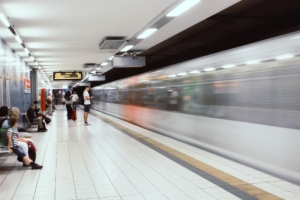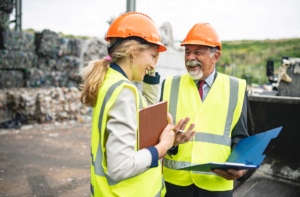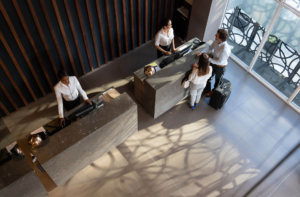What Is Reverse Logistics and How Does it Support a Circular Economy in Business?
Your company is working to prioritize sustainability in all the obvious areas, but your ESG score isn’t improving much. Sound familiar? Sometimes, the areas that can have the biggest impact aren’t the most obvious. One of these lesser-known opportunities for improvement is reverse logistics. When pursued with sustainability in mind, a reverse logistics practice can go a long way towards supporting a circular economy.
Today, we’re exploring this concept and highlighting how reverse logistics can improve businesses’ sustainability efforts – moving far beyond merely dumping spoiled or excess goods into the landfill.
Reverse Logistics, Defined
Reverse logistics is the efficient handling and flow of goods from their traditional final destination back to the manufacturer or similar location for purposes including removal, transportation, recycling, repair, and sustainable end-of-life solutions. This process isn’t just about disposing of waste; it involves optimizing operational efficiency in distribution centers, warehouses, and across the entire supply chain – all with a focus on sustainability. It’s the opposite of traditional logistics, where products move from the manufacturer to consumer.
In the B2B space, reverse logistics encompasses things like returning faulty equipment to the manufacturer for repair, recycling packaging materials, sustainably disposing of spoiled goods, or even refurbishing products for resale. For example, companies like Dell use reverse logistics by recycling and reusing parts, contributing to waste reduction and resource efficiency.
Given the wide range of use cases, it’s no surprise that the global reverse logistics market is growing rapidly; it’s expected to reach $603 billion by 2025, growing at an annual rate of 4.6% from 2018 to 2025, found Allied Market Research.
Industry Example: Cisco Systems, Inc. runs a well-established takeback program where customers can send back old equipment instead of sending it to the landfill. The highly successful program has not only enhanced customer relations, but it’s also contributed to a 40% reduction in waste through recycling and reusing components. If you’re curious about starting a takeback program for your customers, learn how we can help here.
Supporting a Circular Economy
The circular economy is an economic model aimed at eliminating waste and promoting the continual use of resources, representing a fundamental shift away from the traditional “take-make-waste” linear model. In this new system, everything has value and nothing is discarded unnecessarily. By embracing reverse logistics, businesses can:
- Reduce waste. By reusing and recycling products and materials, this practice minimizes waste going into landfills.
- Extend product life. Through refurbishing and repairing, products can enjoy an extended lifecycle.
- Foster sustainable growth. Aligning reverse logistics with the circular economy supports sustainable economic growth through resource efficiency and innovation.
Reverse Logistics Use Cases
In a world where resources are finite, making the best use of what you’ve already produced is essential. Here’s how reverse logistics plays a crucial role in sustainability, with some real-world examples:
- Recycling or upcycling products. One retailer had an excess of candles they needed to dispose of. So we helped them break down these thousands of candles into individual components like glass, wax, and wick and recycle or upcycle every component. This process ensured that nothing went to waste, reflecting their commitment to a circular economy.
- Redirecting spoiled food to generate biofuel. Spoiled food doesn’t have to go to waste. By redirecting it to anaerobic facilities through organics recycling, it can be transformed into valuable biofuel, turning a potential loss into a sustainable win. We helped a peanut butter company do just that.
- Handling recalled items responsibly. Transporting recalled items from multiple retail locations back to the manufacturer is an essential part of reverse logistics. This process ensures that products are handled responsibly, rather than ending up in landfills.
- Clearing operational obstacles. Operational downtime can be costly. By efficiently clearing corrugated cardboard blocking bay doors and hauling them off to a recycling center, for example, reverse logistics eliminates these barriers, allowing businesses to run smoothly and sustainably.
- Facilitating milk runs. Transporting goods from multiple grocery stores to a rendering plant is another application of reverse logistics. These “milk runs” ensure that products are repurposed effectively, minimizing waste and contributing to sustainable practices.
Finding a Sustainable Reverse Logistics Partner
Choosing the right reverse logistics partner isn’t just about efficiency; it’s about aligning with your sustainability goals. Look for partners who can offer sustainable solutions that fit your unique business needs, from handling organic materials to providing end-of-life solutions that go beyond mere disposal. Through CheckSammy’s reverse logistics service, our nationwide network of drivers and facilities specializes in timely removal and handling of goods, ensuring that waste becomes an opportunity rather than a problem. Contact us today to learn more.
See Our Services
Create a custom solution to meet your waste and sustainability goals. Contact us today!
Continue reading
Dive deeper into the CheckSammy Blog by reading one of our posts below
Feeling the Pain of Higher Resident Turnover? Apartment Junk Removal Can Help
If you’re a property manager, you’ve probably had a significant increase in tenant turnover over the last couple of years. So it’s no wonder apartment junk removal may be top of mind for you right now. There are several reasons for this shift. For one, the housing market is on fire right now. In 2020 […]
Read More About Feeling the Pain of Higher Resident Turnover? Apartment Junk Removal Can HelpSetting Up a Community E-waste Recycling Program
E-waste is the fastest-growing municipal waste stream according to the EPA, yet e-waste recycling isn’t keeping pace. In fact, only 12.5% of all e-waste is recycled, reports the EPA. Starting a community e-waste recycling program is a terrific way to ensure hazardous e-waste, like lithium-ion batteries, doesn’t end up in your community’s landfill. Creating an […]
Read More About Setting Up a Community E-waste Recycling ProgramWaste Management’s Role in the Circular Economy
Establishing a waste management program for your business or community is one of the best ways you can contribute to the circular economy. Here’s everything you need to know about waste management’s role in the circular economy (and how to get involved). What Is the Circular Economy? Our current economic model is all about taking […]
Read More About Waste Management’s Role in the Circular Economy5 Reasons to Consider a Textile Recycling Program for Your Organization
Americans sent more than 17 million tons of textiles to landfills in 2018, a volume that is only increasing every year, reports the Environmental Protection Agency. When you think about the fact that it can take over 200 years for textiles to decompose, it’s easy to grasp how large textile waste’s contribution is to the […]
Read More About 5 Reasons to Consider a Textile Recycling Program for Your Organization8 Benefits of Environmentally Friendly Power Washing Services
If you’re into maintaining the curb appeal of your business or home, then you’ve probably heard of pressure washing. Pressure cleaning involves using high-pressure water spray to remove grime, mold, dust, paint, mud, and other junk from objects or surfaces. Many people worry that pressure washing isn’t good for the environment, but this couldn’t be […]
Read More About 8 Benefits of Environmentally Friendly Power Washing ServicesWhy Our Customers Love Our Full-Service Junk Removal
If you’re looking for full-service junk removal services, you’ve come to the right place. CheckSammy is a one-stop shop for all your junk removal and sustainability needs. From our affordability, simplicity, and unrivaled turnaround times to our innovative sustainability solutions and patented technology and data, it’s clear why some of North America’s biggest companies choose […]
Read More About Why Our Customers Love Our Full-Service Junk RemovalTips for a Stress-Free Move From An Eco-Friendly Junk Removal Company
What does an eco-friendly junk removal company know about moving? Quite a lot, actually. Moving can be an especially chaotic time. You have to pack everything up, get rid of unwanted items, clean your property, load everything up, and move your things to your new location. That doesn’t even include the unpacking and resettling period. […]
Read More About Tips for a Stress-Free Move From An Eco-Friendly Junk Removal CompanyCollege Junk Removal Tips for Student Move-In Day
As the new school year gears up, colleges across the country are looking for ways to clean up their campuses before the new year begins, and many of them want to do so sustainably. College junk removal isn’t easy, though, especially around move-in week—and when trying to do so sustainably. As students move in and […]
Read More About College Junk Removal Tips for Student Move-In Day8 Items Hospitality Businesses May Not Know They Can Recycle
One hotel guest produces 2.5 pounds of trash every single day. Just a single hotel room produces around one cubic yard of waste each month, which totals 200 gallons of waste per room every month. Most of this waste goes straight to the landfill, even though research shows that up to 60% of it is […]
Read More About 8 Items Hospitality Businesses May Not Know They Can Recycle












